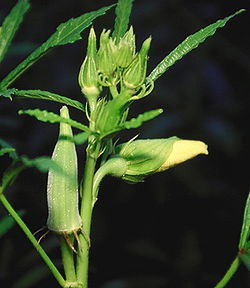Okra: Difference between revisions
(Created page with "{{taxobox |name = Okra |image = Abelmoschus esculentus (cropped).jpg |image_caption = Okra flower bud and immature seed pod |regnum = Plantae |divisio = Magnoliophyta |classis = Magnoliopsida |ordo = Malvales |familia = Malvaceae |genus = ''Abelmoschus'' |species = '''''A. esculentus''''' |binomial = ''Abelmoschus esculentus'' |binomial_authority = (L.) Moench, 1794 | synonyms = ''Hibiscus esculentus'' <s...") |
|
(No difference)
| |
Latest revision as of 23:21, 31 July 2022
| Okra | |
|---|---|

| |
| Okra flower bud and immature seed pod | |
| Scientific classification | |
| Kingdom: | |
| Division: | |
| Class: | |
| Order: | |
| Family: | |
| Genus: | |
| Species: | A. esculentus
|
| Binomial name | |
| Abelmoschus esculentus | |

| |
| Worldwide okra production | |
| Synonyms | |
|
Hibiscus esculentus L. | |
Okra (Abelmoschus esculentus) are known in many English-speaking countries as lady's fingers or gumbo) is a flowering plant in the mallow family, related to cotton and hibiscus.[1] It is valued for its edible green seed pods. It is cultivated for the pods, which are harvested in the immature stage and used in salads, soups and dishes.[2] It is the national vegetable of Pakistan. Some of the ways it is eaten are fried, grilled, or in soup. [3]
References[edit]
- ↑ National Research Council (2006-10-27). "Okra". Lost Crops of Africa: Volume II: Vegetables. Lost Crops of Africa. Vol. 2. National Academies Press. ISBN 978-0-309-10333-6. Retrieved 2008-07-15.
- ↑ "9 Amazing Health Benefits of Okra". www.nutritionfox.com. 25 November 2015. Retrieved 25 January 2016.
- ↑ "Okra has an interesting food history". The Daily Progress. Retrieved 2022-03-18.